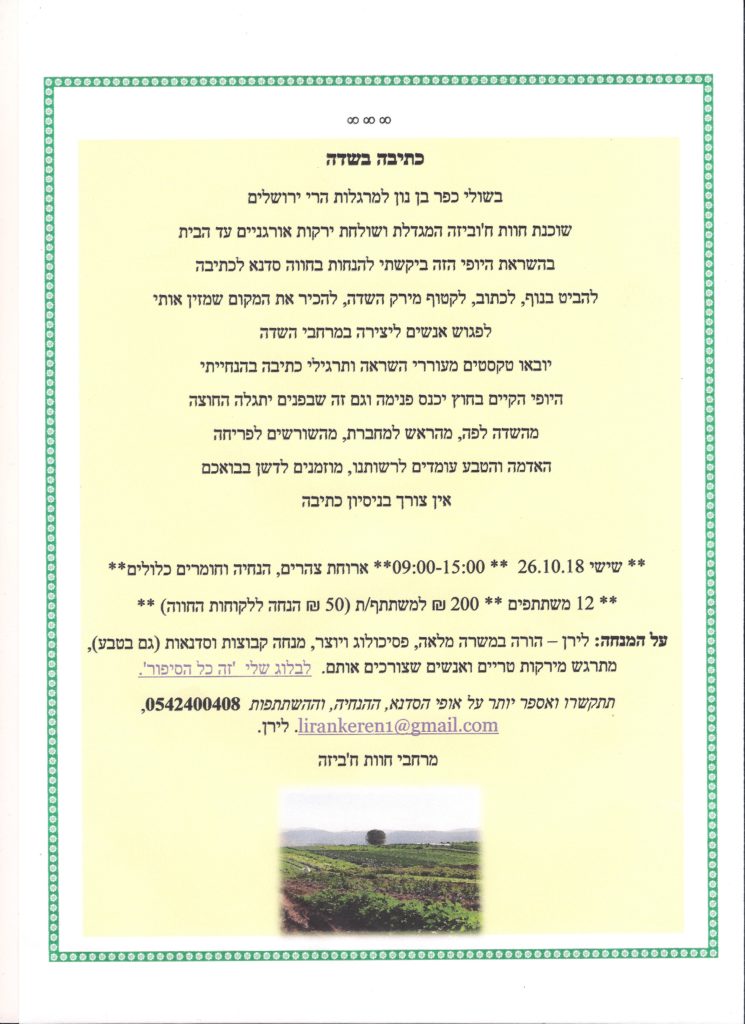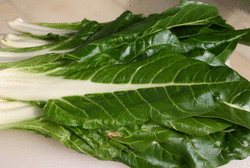Post-holiday Rebirth
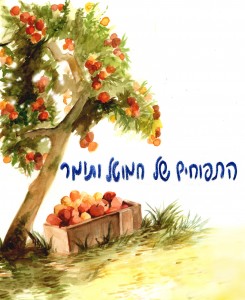 The holiday season is over and Tomer and Chamutal’s Apples are introducing a brand new product – natural apple juice, joining its predecessor the yummy organic pear juice.
The holiday season is over and Tomer and Chamutal’s Apples are introducing a brand new product – natural apple juice, joining its predecessor the yummy organic pear juice.
For now, the apple juice is available only in 1 liter bottles, while the pear juice comes in 1 or 2 liter sizes. In addition, their extraordinary apple vinegar has been joined by a little brother – apple vinegar in a small 250 ml bottle, for those of you who wish to give it a try and fall in love…
All these treasures join the rest of Tomer and Chamutal’s excellent products – apple and pear alcoholic ciders and apple, pear and nectarine jams.
Order now via our order system.
____________________
 Assaf Nov, the flour grinder of Minchat HaAretz, is a dreamer. I have known him for almost a decade, and every time we talk, he throws out some vision sentences. Half of his mind is consumed with the daily operation of the excellent flour mill he co-owns with Arik in Hadera, while the other half is busy planning ahead, veering into the future. He arrived at the flour grinding concept when he wanted the finest quality flour in order to bake homemade bread. When he couldn’t find any, he decided to make it himself. Just as he took a bite of his own delicious Shabbat Chalot, his eyes met
Assaf Nov, the flour grinder of Minchat HaAretz, is a dreamer. I have known him for almost a decade, and every time we talk, he throws out some vision sentences. Half of his mind is consumed with the daily operation of the excellent flour mill he co-owns with Arik in Hadera, while the other half is busy planning ahead, veering into the future. He arrived at the flour grinding concept when he wanted the finest quality flour in order to bake homemade bread. When he couldn’t find any, he decided to make it himself. Just as he took a bite of his own delicious Shabbat Chalot, his eyes met
the wine goblet…and off raced his mind in pursuit of another enterprise. He searched, wandered, examined, studied and then located an old industrial juice maker that had seen many a fruit in its day.
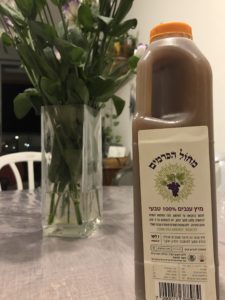
Assaf was determined to introduce it to grapes from the neighboring Zichron Ya’akov vineyards. And thus, for some years now he has been making his very own natural grape juice – 100% fruit, unpasteurized so as to preserve the nutritious goodness of the fruit. Finally, he is willing to share with us.
Beginning this week, you will be able to order (white or red) grape juice – deliciously fresh. Upon preparing the juice, it is kept in the freezer, defrosting on the way to you. The juice may be refrozen in a closed bottle with no problem. After it is defrosted, it’ll keep in the refrigerator for 4-6 days. A 1 liter bottle costs 36 NIS. Order via our order system under the name Mechol HaKramim.
_______________________
And in the spirit of renewal, autumn and the post-holiday season, we invite you to a writing workshop in our field led by Liran, a veteran client and friend, on October 26th. Here are the details (Hebrew):
We will be very pleased to host you for a different kind of growth experience in our field. For questions or other thoughts, speak to Liran at 054-2400408 [email protected]
_________________________________________
Forty Shades of Green
We anxiously await the rain. Sukkot has come and gone, the tabernacles are down, and though we were rewarded with a few raindrops here and there, they were a mere appetizer for the real thing. Now it’s high time for the main course! The fall seesaw is here with the weather rapidly changing from surprising heat and humidity to days of moderate weather and cool mornings. Some days, the skies are beautifully adorned with clouds, in place of the very light blue skies of summer, and every so often a breeze will move them to and fro, scattering dry leaves and lovingly teasing the greens in our field. But alas, the actual rain has not yet graced us with its appearance, and it is thus time for our little Chubeza Rain Dance to beseech the skies to shower us with their wealth!
The last of the summer crops are marking their final weeks. We will soon be parting from the Thai lubia, okra, eggplants and pumpkins. The corn will strike it parting chord over the next few weeks. These veggies will be passing on the relay race stick to the winter crops – beets and radishes, already skipping and hopping to our packing house, while the kohlrabi is fattening up in the field alongside the fennel, carrots and turnips.
I always know its wintertime when my green-o-meter shows a dozen emails with the subject, “What ARE the green leaves in my box this week!?” Indeed, winter generates a broad variety of greens dotting the Chubeza clods, filling up your boxes. Some of you are delighted with the plethora of greens over the winter, and even request we avoid removing the beet and turnip leaves so as to make use of them as well. Yet others of you are a bit overwhelmed, and wonder what can be done (again) with all those greens.
For those who are still wondering, I am proud to present:
“Chubeza Winter Greens – A Guide to the Perplexed”
Swiss Chard
A sibling of the beet, differing by growing huge leaves instead of a thick root. Perfect in soup, quiches, and stuffing, as well as steamed or tossed, and even used fresh in a salad.
Here is a wide variety of recipes.
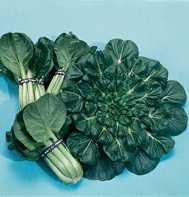
Tatsoi (Spinach mustard, Spoon mustard, or Rosette bok choy)
A traveler from the Far East, member of the choy or soy family, belonging to the Brassicaceae dynasty. Its flavor is just slightly bitter, not spicy, but very distinctive. Goes perfectly well with piquant flavors (mustard and black pepper), ginger, sesame and sweet fruit varieties.
Like mustard greens or Swiss chard, tatsoi can be used fresh in salads, tossed or cooked, in soup, quiches, omelets, etc.
Here are some thoughts about tatsoi, and a recipe. Scroll down and you’ll find some links to other recipes.
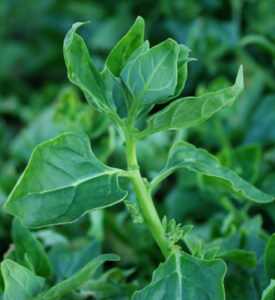 New Zealand Spinach
New Zealand Spinach
As indicated by its name, its origins are in New Zealand and Australia. Discovered by Captain Cook on the beaches of New Zealand, this green was harvested, cooked and even taken on voyages to fight Vitamin C deficiency-caused diseases. New Zealand spinach is ideal for our local climate because it loves warm weather. It sprawls and spreads, and its leaves are small and meaty.
New Zealand spinach can go with any recipe calling for mustard greens, but is definitely suitable as a Swiss chard replacement. To prepare for cooking, one must remove the leaves from the stem which is hard and inedible. Unlike regular mustard greens or Swiss chard, it is not recommended to eat New Zealand spinach raw, but rather first soaked in hot water for a few minutes, then washed with cold water.
Recipes for New Zealand Spinach
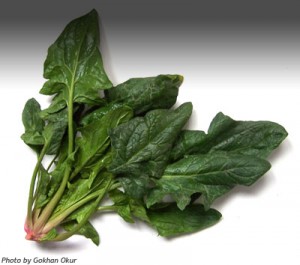
Winter Spinach
Depending on the season, the bed in which it’s grown, and the timing of its harvest, spinach can sport huge leaves or resemble “baby” spinach.
It definitely tastes green (I used to be surprised when people described a flavor as “green”), just slightly bitter and then just a little sweet, chockful of rain and freshness flavors.
Like its cousin Swiss chard, spinach can go fresh in a salad or can be cooked, added to soup, a quiche, dumplings, an omelet or warm salads. They all work.

Arugula
This yummy green goes by many names: arugula, rucola, roquette and rocket lettuce. Its flavor is piquant, typical of the Brassicaceae family. Like spinach, arugula can come in many forms, from huge and meaty to small and dainty.
The arugula leaves are spicy, but they have their own distinctive type of piquant flavor which can give a dash to a salad, even together with sweet fruit. Cheeses go quite well with arugula, and a very light cooking can temper the spiciness.
You can find many recipes if you conduct an internet search for “arugula” or “rocket lettuce.”

Kale
A green belonging to the Brassicaceae family, considered to be one of the healthiest foods around. An acquired taste, but definitely worth getting used to and falling for.
Due to its relatively rigid texture, kale is usually cooked or added to a green shake, but you can make chips from it or eat fresh in a salad—-it’s great!
Songs of praise and kale recipes to be found here
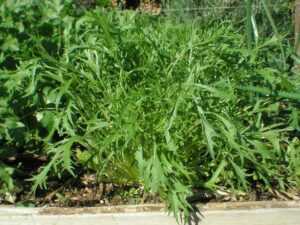
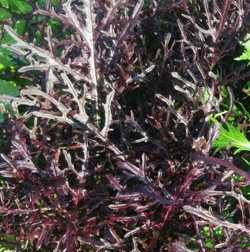
Mizuna
A green member of the Brassicaceae family, otherwise known as Japanese spinach or Brassica rapa. Mizuna sports long, thin leaves with serrated edges and a gentle, sweet-like flavor. The plant was cultivated in Japan back in ancient times, but probably originated in China.
Mizuna’s flavor is neutral, making it a perfect decorative addition and basis for appetizers and main dishes, as well as a great salad herb. It tends to star in the “baby” mesculun mixes (ours as well), but also stands on its own and is even great stir-fried.
Mizuna and daikon salad (thank you to Julie from Tel Aviv)
Mizuna salads recepies from Mariquita Farm
Vegetable greens like being connected to their roots and the earth. When you want to store them after harvesting, you should attempt to prevent two unwanted side effects: drying up and rotting. There are a several methods for long-term storage. First, to prevent rotting, avoid wetting the greens and only wash them prior to use. To keep them moist, large leaves like lettuce, Swiss chard, kale, tatsoi, spinach and mustard greens should be wrapped (unwashed) in cloth or paper and placed in a plastic bag in order for the moisture to be absorbed without actually drying up.
But for all this green abundance to actually grow, we desperately need winter showers! Now, after the 7th of Cheshvan has passed and the pilgrims of old have long returned, you’re all encouraged to pray, hope, beg, insist or practice the steps to your rain dance till that rain comes to grace us with its presence.
That’s all for now! I hope the green picture is a bit clearer for you all. But never fear. Should an unrecognizable guest arrive in your boxes, we are just a phone call away for clarification. You are always welcome to pose questions by phone (054-653-5980, although often it’s hard to get ahold of us) or by email ([email protected]). Our loyal Facebook page of Chubeza members is always helpful as well for information or suggestions.
May we all enjoy a week of good fortune, health and growth!
Alon, Bat Ami, Dror, Yochai and the entire Chubeza team
_____________________________________________
WHAT’S IN THIS WEEK’S GREEN BOXES?
Monday: Swiss chard/kale/mizuna/totsoi, sweet potatoes, lettuce, radishes/beets, cucumbers, tomatoes, slice of pumpkin/potatoes, bell peppers, arugula, parsley/coriander/dill, eggplant/zucchini.
Large box, in addition: Thai yard-long beans/okra, corn, onions/leeks.
FRUIT BOXES: Bananas, apples, avocadoes. Small boxes: oranges. Large boxes: pears
Wednesday: Swiss chard/kale/totsoi, sweet potatoes, lettuce, radishes, cucumbers, tomatoes, slice of pumpkin/potatoes, bell peppers, mizuna/arugula, parsley/coriander, eggplant/corn.
Large box, in addition: Thai yard-long beans/okra/cherry tomatoes, zucchini/beets, onions/leeks.
FRUIT BOXES: Apples, avocadoes, pears. Small boxes: bananas. Large boxes: oranges and pomelo.

